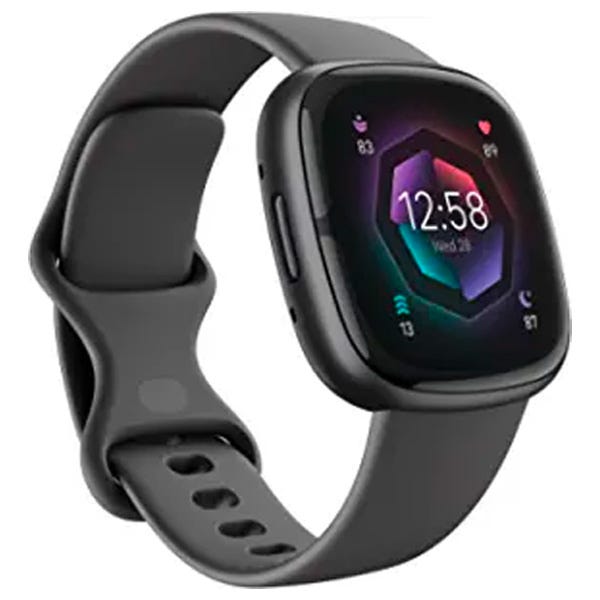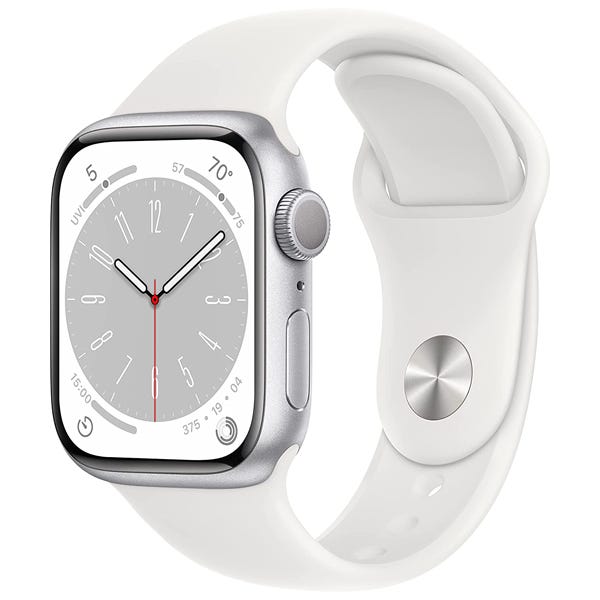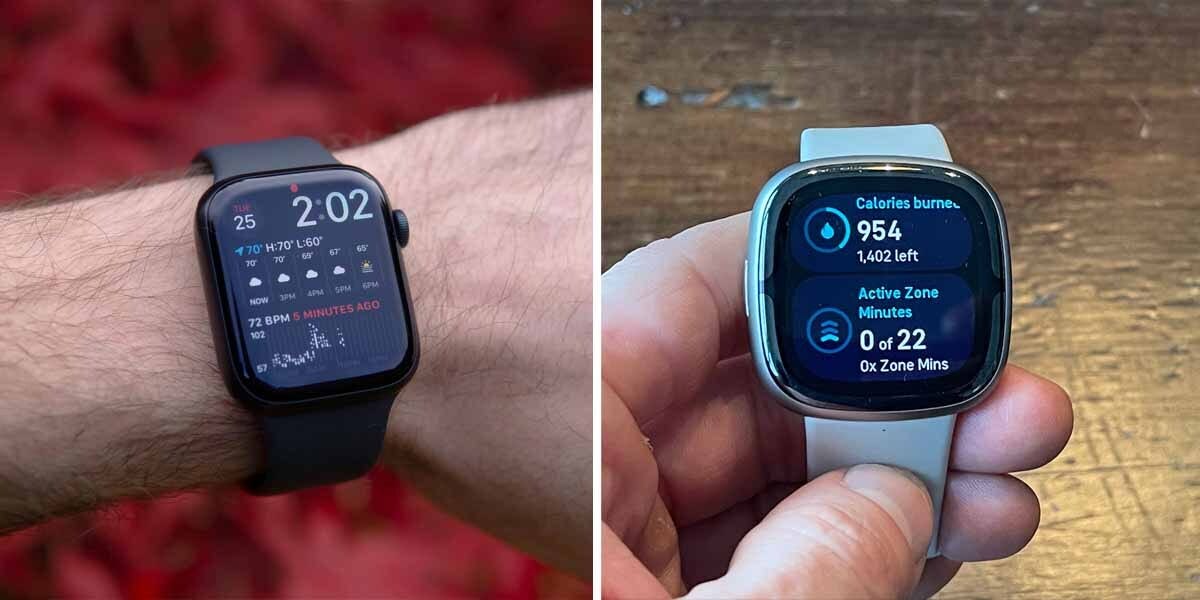When you buy through our links, Insider may earn an affiliate commission. Learn more.
Both the Fitbit Sense 2 and the Apple Watch Series 8 are the latest generation of their brand’s flagship wearable — and are the best Fitbit and best Apple Watch, respectively, you can buy. But there’s a lot to consider when deciding which one is ultimately better.
Beyond price, the main difference between the Series 8 and Sense 2 is their advanced features. Both share the same abilities as a fitness tracker but as a full-fledged smartwatch, the Series 8 offers far more functionality with a wide selection of third-party apps, smarter tools, and cellular connectivity.
But there are still a number of reasons why you’d choose the Sense 2. As Fitbit’s top-tier wearable, it strikes just the right balance between fitness tracker and smartwatch. Here’s how the two watches stack up against each other.
The Fitbit Sense 2 is a premium fitness- and health-centric wearable that introduces new features like real-time stress tracking and skin temperature-sensing, but it comes up a bit short regarding the smarts it offers.
Apple Watch Series 8 vs. Fitbit Sense 2: Specs at a glance
Apple Watch Series 8 vs. Fitbit Sense 2: Design
When it comes to design, the Apple Watch Series 8 and Fitbit Sense 2 have a similar square watch face with rounded edges. The Series 8 is rated as IPX6 dust-resistant and water-resistant up to 50 meters; the Sense 2 does not have an official dust rating but is water-resistant up to 50 meters.
The Sense 2 has a 40.5mm aluminum case with a 1.58-inch display, while the Series 8 is available in either a 41mm or 45mm case and comes in either aluminum or stainless steel. While aluminum is touted for being lightweight, stainless steel is a stronger, more durable material. Depending on your preference, the Sense 2’s smaller size could make it more appealing than the Series 8.
Both watches feature physical buttons and responsive touchscreen controls. The Series 8 has a side button, along with a digital crown button that you can press and rotate for various features. While the original Fitbit Sense had a small touch-sensitive haptic button on the left-hand side of the watch, Fitbit added a physical button to the Fitbit Sense 2, which is easier to operate, especially during workouts.
Overall, both watches are intuitive to use and navigate. But if you want to be able to customize the look of your watch, the Apple Watch Series 8 offers more sizing, color, and band options than the Fitbit Sense 2.
Apple Watch Series 8 vs. Fitbit Sense 2: Smartwatch performance
It’s clear the Sense 2 was built with health and wellness in mind but beyond that, its smartwatch capabilities are limited. For example, you can see your text messages on the watch but if you use an iPhone, you can’t respond. On the Apple Watch, you have easy access to your calendar, podcasts, and other fitness-tracking tools like All Trails or MapMyRun; on the Sense 2, you don’t have access to any of these.
This is because the Sense 2 doesn’t offer third-party app support, meaning you won’t be able to download something like Spotify. While it does have plenty of advanced sensors to offer holistic health tracking, it has fewer “smarts,” which ultimately gives the Series 8 an edge.
By its nature, the Series 8 has more functionality than the Sense 2 because it’s a full-featured smartwatch first and a fitness tracker second. You can text, make calls, and listen to music, and you can also follow step-by-step directions from your phone (complete with haptic feedback for when to turn) or read the news, check your bank accounts, or answer emails.
Apple Watch Series 8 vs. Fitbit Sense 2: Health and fitness tracking
The Sense 2 and Series 8 both use innovative technology to accurately record just about every health data metric you want. While one might assume Fitbit has Apple beat here, the Series 8 includes upgrades that focus mainly on health and fitness tracking capabilities.
Both watches offer built-in GPS, which means you can track runs and outdoor activities without a phone. Other similarities include the ability to track skin temperature (which helps with tracking stress, sleep, and ovulation), blood oxygen levels, sleep, heart rate, and electrocardiogram measurements (ECG).
But there are also some key differences.
If you’re interested in tracking your mental health, the Sense 2 introduced a new Body Response sensor that measures continuous electrodermal activity (cEDA) to track stress levels in real time. The cEDA assesses stress by three metrics: heart rate, heart rate variability (HRV), and skin temperature measurements.
The Series 8 does not measure electrodermal activity but does offer meaningful safety features you won’t find on the Sense 2. In addition to Fall Detection, the Series 8 added Crash Detection and Emergency SOS — and I’ve seen these in action first-hand.
After a fall on my mountain bike, the Series 8 immediately started vibrating and beeping, prompting me to touch the “I’m OK” button to turn off the alerts and avoid calling emergency services. The other option I had was to press and hold the side button to bring up the screen to call emergency services and share my location. It’s a potentially life-saving feature.
The other big difference between these two watches is how each presents its amassed health data. Apple Watch uses its Health and Workout apps, whereas the Sense 2 primarily uses the Fitbit app. To get the most out of either experience, you’ll want to consider subscribing to Fitbit Premium or Apple Fitness Plus.
In total, the Sense 2 tracks 40 different workouts while the Series 8 is compatible with more than 60. In terms of helping you accomplish your fitness goals, the Apple Watch uses rings to set daily markers and baselines, while Fitbit uses active zone minutes.
The Series 8 also leans on the use of the iPhone’s Workout app to view data such as heart rate zones, pace, and customized intervals. The app lets you dig into advanced data such as what your run cadence is or how much running power you have. You can even race against yourself from past workouts.
Fitbit offers a similar experience but in a different package. It offers insight into the heart rate zones you enter while working out while also analyzing your pace. It serves up a Daily Readiness Score which assesses your previous activity for the week, your stress levels, and how much rest and recovery you’ve had to let you know how hard to push yourself that day.
Apple Watch Series 8 vs. Fitbit Sense 2: Battery life
One of the main reasons you’d want the Fitbit Sense 2 over the Series 8 is its battery life. Fitbit says the Sense 2 lasts up to six days on one charge, though I found that estimate to vary depending on if I used the always-on display or activated the continuous GPS. Still, it has one of the best batteries for any wearable.
In comparison, the Apple Watch Series 8 lasts roughly 18 hours. It should be noted that the Series 8 does have a new Low Power Mode that promises up to 36 hours of battery life. But in exchange for more juice, Low Power Mode disables core features that make the Series 8 useful in the first place, so I don’t recommend using it on a regular basis.
Which should you buy?
Both watches are comfortable to wear, stylish, slim, and easy to use — and they each offer a number of helpful tools to improve your health and wellness. Along with general fitness tracking, these watches both have high-tech features like ECG and blood oxygen readings, temperature sensing, and sleep tracking.
The Apple Watch Series 8 costs $100 more than the Fitbit Sense 2 but it is a more full-featured smartwatch. The Sense 2 is more fitness-focused with only some smart capabilities.
When you ultimately pick out which watch is best, it’s important to take into account the kind of phone you’ll use it with. The Sense 2 works with both Android- and iOS-enabled phones, though it can’t call or text from the Fitbit when paired with an iPhone. Conversely, the Series 8 is only compatible with iOS-enabled phones.
If your main focus is on tracking fitness metrics, opt for the Fitbit Sense 2. If you want to focus on your fitness and have a watch that works for day-to-day smart needs, the Series 8 is the better choice.


Read the full article here





